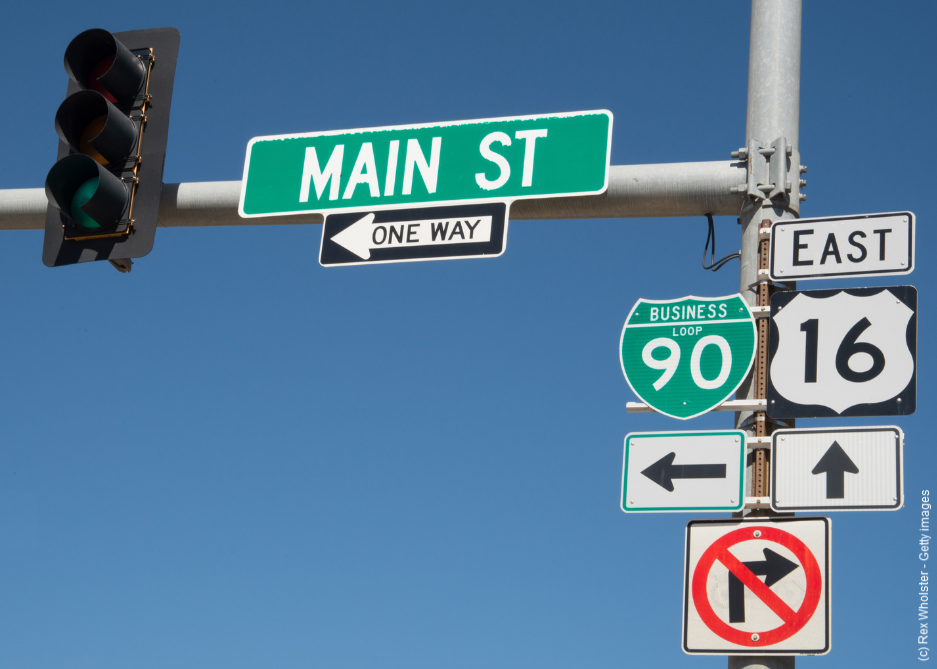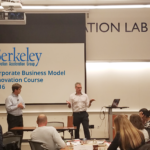If your company were a road, what kind of road would it be? Are you a Main St, a subdivision cul-de-sac, a dusty country road, a 4-lane highway? Take a minute and think about that. Don’t worry, the rest of the article will wait for you.
If your company is truly innovating, your business should be running like a multi-lane highway, and your employees and projects following the rules of the road.
This article is about existing businesses that have already found and executed at least one repeatable, scalable business model. That being said, I’ll take a quick detour and talk, about entrepreneurial and non-corporate innovation ‘ecosystems.’ The highway system analogy applies to those as well but that’s another post. Simply put, if your accelerator/incubator space or program wants to truly be an ecosystem and thrive, it needs to be a multi-lane highway with an expressway, same as an innovative business. That concludes our detour through Startup Ecosystem-ville. If your company is at a scale and stage where you can put resources into structured and dedicated innovation programs, you should be running at least a four-lane highway with a dedicated tollway/expressway on the left.
Innovation as a highway system

So, why a highway? Well, for a lot of reasons we will dive into throughout the article but to start, highways are a path somewhere. Using them implies you want to go somewhere and go faster than the start-stop Main Street allows with all its traffic lights, stop signs, and dudes in pick-up trucks waiting to turn left. This is where most entrepreneurial endeavors and businesses live – on Main St. As a matter of fact, 99.9% of business in the U.S.A. are “small businesses” and that’s fantastic! Some businesses are trying to get off Main Street though. If that’s where you are, then that’s the first step for your business – build a highway; a process in which there aren’t constant starts and stops built into your product/program/service development process.
Another reason I like the highway analogy is because there are designated entry points and exit points on a highway. When it’s time for your business product to get on the highway, it can. Then, if/when the time comes it’s no longer needed as part of your core business, it can take the next exit. And maybe that exit is for a rest stop where it hangs out for a bit, and maybe that exit is towards its home somewhere else – it’ll find a Main Street somewhere to live happily ever after because it found its happy home.
Fitting your products and employees in this highway
So, in our Business Highway analogy, are the cars your employees or your products? Or both? If the company is the highway system, architected and designed by the C Suite, then the projects are the cars on the road and the employees are the passengers either driving the car or along for the ride in the passenger seats. You might have a bus-sized project full of 20 employees, chugging along at a solid, predictable pace (Think People Ops and Finance).
You probably also have the little sports car with two employees cruising along with the top down, there for the ride and looking cool more so than being efficient and effective on their trip down your business highway. Then there’s the football SUV – small crew, multi-purpose, can tackle bad weather like a walk in the park, there to get a lot done in an efficient and reliable manner. So, your vehicles and your passengers in those cars are your Projects/Business Groups and the Teams that drive them forward.
Understanding the road lanes (and using the right one)
That brings us back to the highways our Project/Business Groups/Teams are traveling on. We’re going to pause here for a quick roadside alert – this article is written from the perspective of a road system where driving is done on the right-hand side of the road. If you are reading from a country that drives on the Left, please temporarily adapt your thinking before continuing on this article journey to avoid some major crashes down the road. On a four-lane highway, the right lane is your travel lane. It’s not where you start to get up to speed after entering the business highway. For the love of Pete, that’s what the merge lane is for! (no road rage here at all, folks…) The travel lane is for when you are comfortable, settled in for the long haul. You can set your cruise control and just plug along on your journey down the road. These are your Core Business vehicles. If you’re Apple this is your MacBook or for Starbucks this is your grande non-fat latte with extra foam (a.k.a a cappuccino…)
The left lane is the passing lane which in our case means the Innovation Lane. The lane where you go fast – maybe zoom past the others because you’ve developed a super-fast vehicle or because you have to get somewhere faster than the cruise-controlled Core Business vehicles are going. Maybe you don’t have it all figured out yet and you can’t set your cruise control, maybe there’s an emergency and you have to put on your flasher lights, or maybe your vehicle is over there in the Innovation Lane because you want to look cool and just because you can – it makes you feel better to travel in that lane – even if you don’t really need to be there.
That brings us to traffic flow and when something disrupts it. I’m referring to that jerk on cruise control right at the speed limit in the left Innovation Lane or that one car in the right Core Business Lane who just can’t seem to get up to the minimum speed limit or isn’t comfortable doing so and maybe should be taking the side roads instead of the Business Highway. Every now and then, one of those vehicles in the Core Business travel Lane might get a flat tire or have engine trouble and the others traveling in that lane have to pop over to the left lane as they innovate a way to keep going, despite the disruption of the temporarily disabled vehicle. Once they found their solution, got around their slow boat co-vehicle, they get back in the Core Business Lane.
Building a multi-lane highway
If you’re a company that, like most others, has decided to build and operate a two-lane highway, that means your innovators are forced to travel in line with the core business. When they run into a “slow” core business keeping them from going the speed they desire, they either stop or slow down and get frustrated then give up. They may pull out around the Core Business vehicles in the oncoming traffic lane or drive on the shoulder, kicking up all sorts of dust and debris, making everyone nervous, and then when they decide they are ready to be back in the Core Business Lane because they think they found a happy, comfortable space for themselves in the traffic flow or because it’s no longer safe or viable to be traveling in the on-coming traffic lane or on the shoulder, they zig back into the Core Business Lane. They cause those who had already been traveling in the lane to swerve or hit their breaks to make room. They slow the pace and progression of your entire company’s Business Highway and spread road rage, whiplash, and car sickness amongst your drivers and passengers.
That’s why, if you want to effectively and sustainably innovate you should build a multi-lane highway. Yes, things will get slow and congested a little while you expand your highway. With a good construction plan, you can mitigate the disruptions of building your new Innovation Lane. If you’re a forward-thinking CEO, looking to build your company’s Business Highway system to support future company growth and needs, I recommend you build in a third lane – whether you are doing your initial highway build or doing construction. This third lane is your Structured Innovation Program Lane, your part or full-time HOV lane, or your Express Lane, depending on your organization’s needs. This lane is a dedicated, protected space, with slightly different rules of the road than the other lanes on your highway. Vehicles in that lane can go faster than the rest of the business units.
Investing in your highway: build a proper fast lane
Often, there’s an extra cost to travel in that fast lane. In this analogy, those are the fees you pay to an outside organization for coaching services to help teach your company how to develop a scalable, repeatable internal innovation process. If they are good at their jobs, they will work themselves out of their job – just as the tolls paid by vehicles using the lane eventually pay off the construction cost of the tollway (or at least they are supposed to…) Here’s the crux of the analogy though: you could have the best-designed and laid out concrete jungle Business Highway system in the world, but if you don’t put up signs to help teach your drivers how to use it properly, it won’t matter. The signs that teach and reinforce the rules of the road are what create the driving culture on your highway system (and hiring drivers/people who know how to read and respond appropriately to those signs…but that’s also a different article.) Culture is the result of shared, repeated behaviors of enacting the process set forth by the leadership.
If your driver’s license manual doesn’t tell people how they should properly change lanes, it’ll be a cluster jam. When speed limit signs say 75 MPH but your traffic cops pull people over for speeding at 70 MPH; no one will be happy. If you have clear signage that allows everyone to know where they belong on the highway based on where their vehicle is going and how it’s trying to get there, as well as driver’s manuals defining lane change practices*, then your drivers will be happy and traveling your Business Highway will be smooth sailing (except for the occasional pothole… but highway maintenance is a different article.)
*Proper lane change procedures: put on your indicator, look around make sure you won’t be crashing into someone else and impeding their progress as they speed up the lane next to you, then execute your lane change (and turn your indicator off, for the love of Pete!) This same procedure applies to your biz highway vehicles when they change lanes.
Own your business’ innovation highway system!
So, for you LA CEOs out there who hate sitting in traffic on the 405 because drivers don’t know how to merge and change lanes properly, they don’t get in the right lane early enough for their exit, they like to travel at the speed limit in the passing lane, and occasionally they aren’t paying attention and they bump into the car in front of them, all-in-all causing one giant cluster… imagine how your employees feel. Unlike on the 405 where you don’t control the construction, drivers’ education, signage, learned habits, and culture, you do control the highway system of your business.
You are the architect who built the highway system and who decided when and how to put it under construction for repairs, improvements and beautification; you are the course designer who created the driver’s educational content; you and your senior leadership the arbitrators of which vehicles are allowed on the highway and who’s driving each of them and y’all are also the traffic police who cite drivers for violations and respond when there’s been a collision.
So, Miss (or Mister!) CEO, while you sit in traffic on the 405 pondering the miserable state of the situation, ask yourself – is this how your employees feel sitting on the Business Highway system you’ve built? If you think the answer is yes, sit with that for a minute. Own it. Then start coming up with a plan to resolve it. (If your plan is to do a sweeping reconstruction of your whole business highway system – remember what it’s like to be stuck in construction traffic…on the 405…)
This post is the roadside billboard part of the highway analogy. As you make your plan to construct your amazing multi-lane Business Highway system, you’ll need nourishment. No doubt you’ve seen many billboards for fancy restaurants which for us equate to corporate innovation consultants, books, and week-long innovation leadership classes at premier institutions and organizations. Some are attention-grabbing, some are boring, and some are confusing. Don’t just pick partners to develop your Business Highway with based on a billboard. Call the number listed, ask for references, and don’t be distracted by the fancy 3-D animated sign.
Fancy signs don’t equal good quality nourishment. If you’ve ever road-tripped, you know some of the best food you stopped for has been from the café who had a little hand-painted sign nailed to a fence post along the highway. IAG is one of those roadside cafés. Drawing on our expertise, after decades of cooking, my colleagues and I focus on serving a full-contact, immersed with the locals, unique and deliciously flavored experience for every client that comes to our door.
Do you have to eat at IAG to satisfy your innovation hunger? No. But you have to eat somewhere along your journey. And so far, our food has never sent anyone speeding towards the next exit or pulling off to the shoulder for a bathroom emergency.




